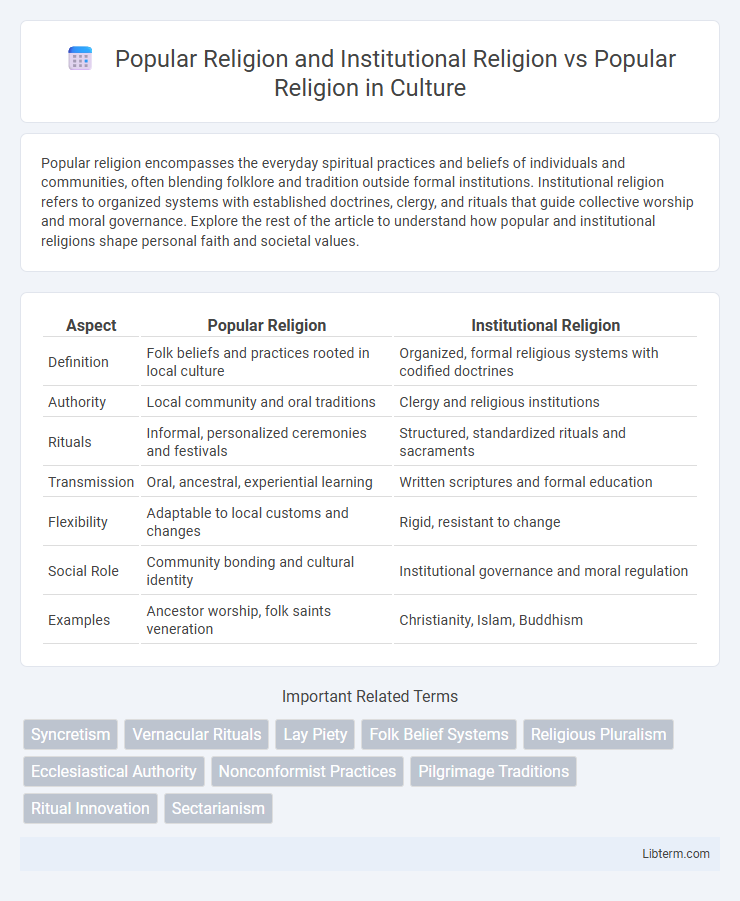Popular religion encompasses the everyday spiritual practices and beliefs of individuals and communities, often blending folklore and tradition outside formal institutions. Institutional religion refers to organized systems with established doctrines, clergy, and rituals that guide collective worship and moral governance. Explore the rest of the article to understand how popular and institutional religions shape personal faith and societal values.
Table of Comparison
| Aspect | Popular Religion | Institutional Religion |
|---|---|---|
| Definition | Folk beliefs and practices rooted in local culture | Organized, formal religious systems with codified doctrines |
| Authority | Local community and oral traditions | Clergy and religious institutions |
| Rituals | Informal, personalized ceremonies and festivals | Structured, standardized rituals and sacraments |
| Transmission | Oral, ancestral, experiential learning | Written scriptures and formal education |
| Flexibility | Adaptable to local customs and changes | Rigid, resistant to change |
| Social Role | Community bonding and cultural identity | Institutional governance and moral regulation |
| Examples | Ancestor worship, folk saints veneration | Christianity, Islam, Buddhism |
Defining Popular Religion: Characteristics and Practices
Popular religion encompasses the everyday beliefs, rituals, and practices of ordinary people that often blend official doctrines with local traditions, emphasizing personal and communal spirituality. It is characterized by its adaptability, syncretism, and the integration of folk customs, healing practices, and festivals that may not strictly align with institutionalized norms. Unlike institutional religion, which is formally organized and doctrinally standardized, popular religion thrives on informal transmission and localized expressions of faith.
What Constitutes Institutional Religion?
Institutional religion is characterized by organized structures, formal doctrines, established rituals, and a centralized authority that governs religious practices and beliefs. It typically involves codified scriptures, clergy leadership, official places of worship, and a community bound by shared regulations and hierarchical oversight. This framework contrasts with popular religion, which is more fluid, localized, and centered on individual or communal expressions of faith outside formal institutions.
Historical Development of Popular Religion
Popular religion emerged as grassroots expressions of faith, often rooted in local traditions and oral practices, distinct from the formal doctrines of institutional religion. Its historical development reflects adaptation to social, cultural, and economic contexts, blending indigenous beliefs with established religious frameworks. Over time, popular religion has influenced and been influenced by institutional religion, creating a dynamic interplay between official dogma and lived religious experience.
Core Beliefs and Rituals in Popular Religion
Popular religion centers on lived practices and everyday rituals reflecting community beliefs, often blending local customs with formal doctrines. Core beliefs in popular religion emphasize direct interaction with sacred forces, ancestral spirits, or saints, creating personalized expressions of faith distinct from institutionalized dogma. Rituals such as festivals, pilgrimages, and votive offerings reinforce communal identity and spiritual connection beyond official religious frameworks.
Institutional Religion: Structure, Authority, and Doctrine
Institutional religion is characterized by formalized structures, centralized authority, and codified doctrines that regulate beliefs and practices within a community. It maintains hierarchical leadership, often through clergy or religious officials, who interpret sacred texts and enforce religious laws. This organized framework ensures uniformity, continuity, and collective identity among adherents, distinguishing it from the more fluid and varied practices found in popular religion.
Popular Religion vs Institutional Religion: Key Differences
Popular religion emphasizes everyday spiritual practices and beliefs rooted in local culture, often transmitted orally and manifesting in festivals, rituals, and folk customs. Institutional religion, in contrast, is characterized by formal doctrines, structured clergy, codified scriptures, and centralized authority that governs religious practice. Key differences include the fluid, adaptable nature of popular religion versus the rigid organization and standardized teachings of institutional religion.
Syncretism and Adaptation in Popular Religion
Popular religion often demonstrates significant syncretism, blending indigenous beliefs with elements from institutional religions to create hybrid practices that resonate with local cultures. This adaptive characteristic allows popular religion to evolve dynamically, integrating rituals, symbols, and deities from multiple sources, which institutional religions may reject or standardize. Such syncretism in popular religion highlights its role in maintaining cultural identity while simultaneously accommodating external religious influences.
The Role of Community in Both Religious Expressions
Community serves as the foundation of popular religion, where shared beliefs and practices are rooted in local traditions and collective experiences, fostering a strong sense of belonging and identity. In institutional religion, community is structured through formal organizations, rituals, and hierarchical leadership that regulate worship and maintain doctrinal consistency across broader populations. Both expressions rely on communal participation to sustain religious life, yet popular religion emphasizes organic, grassroots involvement while institutional religion prioritizes organized, codified community frameworks.
Institutional Responses to Popular Religious Practices
Institutional religion often responds to popular religious practices by formalizing or regulating these grassroots expressions to align with established doctrines and authority structures. This dynamic can lead to the incorporation of popular rituals into official liturgy or the suppression of practices deemed heretical or non-conforming. The negotiation between institutional dogma and popular devotion shapes religious landscapes, influencing cultural identity and communal cohesion.
The Impact of Popular Religion on Modern Religious Landscapes
Popular religion, characterized by grassroots beliefs and practices outside formal doctrines, deeply influences modern religious landscapes by fostering localized rituals and community cohesion. Unlike institutional religion, which emphasizes hierarchical structure and standardized worship, popular religion adapts to cultural contexts, enriching spiritual diversity and resilience. This dynamic interplay challenges rigid dogmas and encourages inclusive reinterpretations of faith in contemporary society.
Popular Religion and Institutional Religion Infographic

 libterm.com
libterm.com